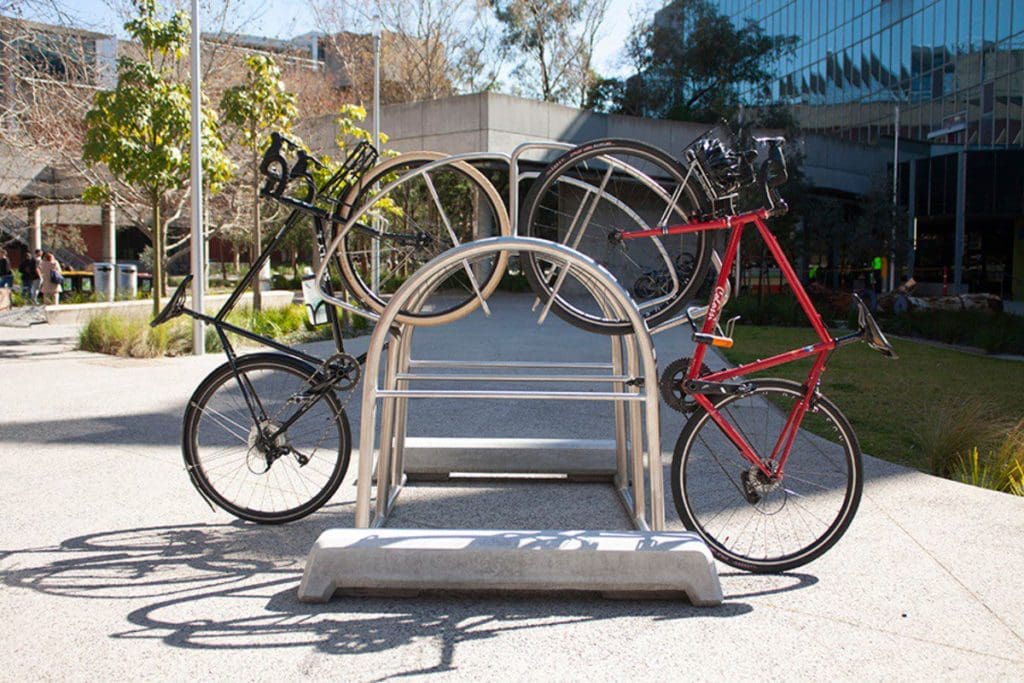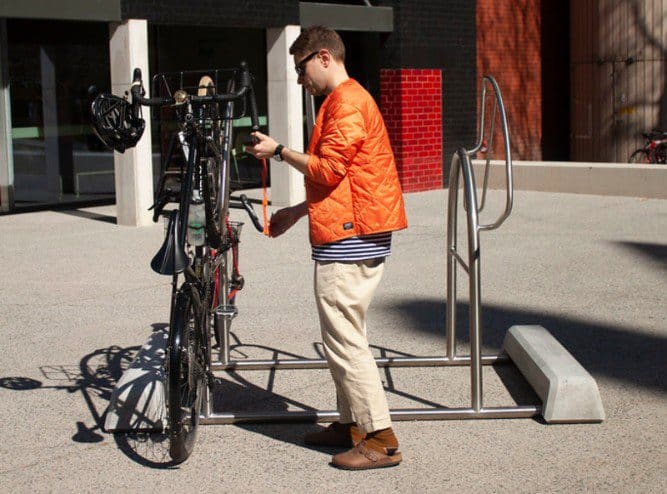A Wheelie Good Rack!

Bicycle parking is a critical piece of the puzzle when it comes to encouraging more people to ride. But before anyone starts drilling holes in public space to install ‘permanent’ bike parking hoops, enclosures or other facilities, they have to jump through expensive hoops themselves in terms of approvals, ensuring they’re not potentially disrupting any underground utilities and so on.
These costs, combined with uncertainty amongst the relevant authorities that the parking would be regularly used, often leads to inaction. No parking leads to less riding and so the vicious cycle repeats.
In Melbourne a solution has been designed, manufactured and successfully used, that overcomes these key challenges.
Dr Robbie Napper is a Senior Lecturer in the Department of Design, which is part for the Faculty of Art, Design and Architecture at Monash University in Melbourne.
He’s had extensive training and career experience as an Industrial Designer. He’s also a keen cyclist himself who has worked in the bike industry, so understands the users’ needs from first-hand experience.
Several years ago, Victoria’s Department of Transport approached Robbie, at Monash University’s Mobility Design Lab with a request.
“The impetus for the project came through a recognition by our state Department of Transport that they had a missing link, as far as bike parking solutions go,” Dr Napper recalled.
“They went from a stainless steel hoop (that typically parks two bikes, one leaning against each side) and at the other end of the scale, a Parkiteer, which is a cage that can hold 20 to 50 bikes. You find them a most major railway stations in Victoria. But they didn’t have anything in between.
“Both of those solutions are quite high cost. The red tape and site survey costs for putting in bike hoops are surprisingly high. Because when you drill a hole into a concrete apron, you’ve got to make sure that you’re not going to hit a pipe or anything like that.
“Likewise, the Parkiteer cages are expensive. They’re small pieces of architecture, so you’ve got all the costs associated with that.
“The government wants people to ride bikes more, but they’re concerned about building facilities if they’re not going to be used.
“Their brief to me was that they’d like to have a bike parking solution that could provide lots of bike parking at low very low cost and that essentially required no commitment. So you didn’t have to dig a hole anywhere, therefore things could be moved around.
“In effect it was a temporary to mid-term solution rather than permanent bike parking rack.”
The Wheelie is Born
In 2018 Dr Napper came up with the Wheelie, so named because for some, but not all of the bikes are stored with their front wheel high in the air, just like when someone ‘pops a wheelie’ and rides along on their back wheel.
This is one of three key design elements that make the Wheelie so cost and space effective.

Dr Napper explained, “As anyone with a bike can appreciate, handlebars, and to a lesser extent, pedals, are the things that really get in the way, when you want to park a bike. In particular it’s when one bike’s handlebars get tangled in the space of another bike.
“That’s a bad outcome for the user and they’ll get annoyed at the bike parking and they might drive their car instead, so we really have to avoid that. The Wheelie you can see in the photo has enough space for three bikes in the wheelie, upright position, then the other three to six bikes get parked just like they do with a regular hoop, where you lean your bike against the hoop.
“We designed this to fit, in theory, six bikes. But as you know, with bike parking, if you put bike rack in a good spot, you’ll get more bikes parked in it than you bargained for. Often this rack has 10 to 12 bikes parked on it.”
The second key element was careful consideration of the rack’s footprint.
“It’s designed to fit inside an Australian Standard off-street car parking space,” Robbie continued. “It goes crossways, so the bicycle wheels would be in the same plane as the car wheels.”
“It’s just a shade under 2.4 metres long because that’s the width of a standard car parking space.
Thirdly, the Wheelie is requires no drilling into the ground or any other permanent installation work. It’s simply lowered into position in three parts, the rack itself and the two weights, one at either end.
“The concrete blocks are sitting on top,” Robbie explained. “They’re designed to enclose both the top and the ends of the bars. There are no bolts or anything. They’re an ‘interference fit’ – a tight fit on top of the stainless steel bars.
“They weigh a couple of hundred kilos. The idea is they’ve got to be heavy enough to secure the rack, but light enough to be workable.
“The local council or railway workers normally have a light truck with a small crane attached to it that can handle this job. The actual steel rack itself is very light weight.”
What’s the Bottom Line?
“Our target cost was $1,000 and we hit that cost when we get an order of eight units,” Dr Napper revealed, noting that this price includes both rack and the blocks that weigh it down.
“There were a couple of reasons for that cost in the design brief.
“Number one is that a single bike hoop runs at around $800 to $1,000, which is a lot considering the physical hoop costs much less. The balance is to overcome the red tape around installation.
“The second reason was, as a low cost object, it makes it more accessible. For example, let’s say you’re a school principal or a local government officer with a corporate credit card. You can actually buy a Wheelie on your corporate credit card and you don’t have to go through all of the acquisitions red tape.
“One of the other objectives of the project was that we agreed with the state government that when we finished the project, we would make the design ‘open source’. We still own the intellectual property (IP) but anyone can download the drawing and get one made.
“The concrete plinths in the photo are custom moulded. Once you make one mould, the actual cost to make the parts, is cheap. However, any heavy object, like a recycled railway sleeper will do the job.”
Keeping it Local
So far, a local Melbourne concrete product manufacturer has made the mould for the blocks and can make additional blocks at low cost upon demand. Well known bicycle rack manufacturer Grip Sport, also based in Melbourne, have been making the racks, which they make to order and can ship to any destination.
But given the open source design, there’s no reason that suitably skilled and equipped manufacturers elsewhere in Australia could not also start popping Wheelies…
If you’d like more information about the Wheelie project you can visit Monash University’s website, which includes links to both the design plans and to contact Dr Robbie Napper. The manufacturer Grip Sport can be contacted on their website.
This article was originally published in the Micromobility Report.
